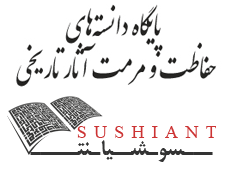سودابه یوسفنژاد
مطالعهی فنی و ارائهی طرح حفاظت آجرهای لعابدار بهدستآمده از کاوشهای باستانشناسی در محوطهی هخامنشی تلآجری استان فارس
پایاننامهی کارشناسی ارشد،
دانشگاه آزاد تهران (دانشکدهی معماری و شهرسازی)، 1392
استاد راهنما:
رضا وحیدزاده
استاد مشاور: محمدحسن طالبیان
چکیده:
در این پژوهش آجرهای لعابدار هخامنشی بدست آمده از کاوشهای باستانشناسی تلآجری درشهر پارسه مورد مطالعهی فنی قرار گرفته و بر این اساس طرح حفاظت از این آثار ارائه شده است. شناسایی ترکیبات سازندهی لعاب رویه و بدنهی آجر به کمک روشهای متعدد شیمی تجزیه کلاسیک و دستگاهی از قبیل: XRF، XRD،ICP ،EDS-SEM و میکروسکوپ نوری انجام شد. نمونه لعابها ظاهراً به رنگهای سفید و زرد میباشند فرایندهای فرسایش سبب حالت پودری و رنگباختهی آنها شده است، بطوریکه قسمتهای پراکنده از لعاب آبیرنگ بر روی زمینهی فرسودهی سفید به کمک میکروسکوپ نوری یافت شد، در بازپخت نمونه درحرارت ۹۰۰ درجه با کمک ذوب نیز رنگ آبی نمایان شد، نتایج حاصل ازتجزیه کمّی عنصری با حساسیت بالا در این نمونه وجود عناصر عامل ایجاد رنگ آبی از قبیل مس و کبالت و در نمونهی زرد رنگ آنتیموان و سرب را مشخص نمود. با توجه به ناپایداری این ترکیبات رنگساز در دمای بالای ۱۰۰۰ درجه آجرهای لعابدار در دمایی کمتر از آن پخت شده اند. نتایج تجزیهی عنصری این لعابها با لعابهای آجرهای لعابدار هخامنشی کاخ آپادانای شوش مقایسه شده است. ملات قیر بهکاررفته در آجرهای تلآجری نیز به منظور شناسایی اجزای سازنده و بررسی فرایندهای فرسایش با روشهای شیمی تجزیه دستگاهی ازقبیل FT-IR ،XRD, XRF و روشهای میکروسکوپی و جداسازی کلاسیک مورد مطالعه قرار گرفته است. براساس آزمایشات جداسازی این ماده به لحاظ فیزیکی مخلوط است و از بخشهای آلی و معدنی تشکیل یافته است، جزء آلی این مخلوط طبیعی به روش FT-IR مورد تجزیه قرارگرفت، نتایج تجزیه پرتو ایکس XRF و XRD عناصر وانادیم، کلسیم، گوگرد و ترکیب آلی آسفالتین را در این مخلوط قیری شناسایی کرده است. فرایندهای فرسایش درطی سالیان سبب کاهش بخشهای اشباع و رزینها و افزایش غلظت آسفالتین شده است.
Abstract: Achaemanid glazed bricks of Tal-e-ajori were found from archeological excavation of Persepolis city, are technically studied in this research then the conservation plan of architectural remains is proposed based on the analytical results. For identification the composition of glaze layer and brick body multiple instrumental analysis methods such as XRD, XRF, ICP, SEM-EDS and classical analyzing also optical microscopy are applied. Glazed samples are apparently white and yellow. Deterioration processes cause to real color gets faded and has made the glaze layer to become powder during thousands of years. According to optical microscopy little spread colored area were found in the white substrate of glazed layer; ICP elemental analysis results determined the presence of copper and cobalt as producer blue color and lead, antimony in the yellow one in the analyzed glazed sample also re-firing test of glazes with flux up to 900⁰C clarified the glaze color. According to presence of chromophore agents such as copper and antimony compounds and instability of them in temperature more than 1000⁰C the Achaemanid glazed bricks could be fired less 1000⁰C. Comparison of the results of elemental composition of Tal-e-ajori samples with Susa samples show similarity in coloring agents of glazes. The natural asphalt that was applied as water proof mortar between bricks of Tale-e-ajori for identification the composition and deterioration, were analyzed by different instrumental analysis method such as FT-IR, XRD, XRF, optical microscopy and classical extraction methods. According to the extraction with organic solvent, the material is the compound of organic and inorganic parts. The organic parts were analyzed with FT-IR for identification of organic functional groups. X-ray analysis XRF and XRD results show presence of Ca, V and S also the complex organic compound, asphalten. Deterioration processes during thousands of years decrease saturate and resin parts in the compound and increase the concentration of Asphalten.
